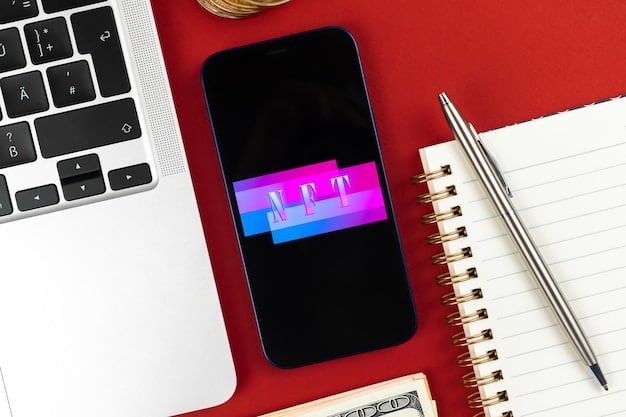Streaming Data Usage: Cut Bandwidth & Avoid Overage Fees

Streaming service data usage can be significant, but minimizing bandwidth consumption and avoiding overage fees is possible through adjusting video quality, downloading content, monitoring usage, and exploring data-saving features.
Are you tired of unexpected data overage fees from streaming your favorite shows and movies? Understanding and managing streaming service data usage: how to minimize bandwidth consumption and avoid overage fees is crucial for budget-conscious streamers. Let’s explore practical strategies to keep your data in check.
Understanding Streaming Service Data Consumption
Streaming has become a ubiquitous part of modern life, offering on-demand access to a vast library of content. However, this convenience comes with a cost: data consumption. Understanding how different streaming services consume data is the first step in managing your bandwidth effectively.
Different factors impact how much data streaming consumes. Video quality, resolution, and audio quality all play a significant role in determining the amount of data used per hour. For instance, streaming in Ultra High Definition (UHD) can consume significantly more data than Standard Definition (SD).
Factors Influencing Data Usage
Several factors influence how much data streaming services use. Understanding these factors can help you make informed decisions to conserve bandwidth.
- Video Quality: Higher resolution video consumes more data. Adjusting video quality to a lower resolution can significantly reduce data usage.
- Audio Quality: Streaming with higher audio quality also increases bandwidth consumption. Lowering audio quality, if available, can help save data.
- Streaming Platform: Different platforms use different compression algorithms and encoding techniques, affecting data usage.
Estimating Data Consumption Rates
Estimating data consumption rates can help you track and manage your bandwidth effectively. Here’s a general guideline:
- Standard Definition (SD): Approximately 0.7 GB per hour
- High Definition (HD): Approximately 3 GB per hour
- Ultra High Definition (UHD): Approximately 7 GB per hour
By understanding these data consumption rates, you can estimate how much data you’re using each month and make adjustments accordingly. Lowering video quality and downloading content for offline viewing can significantly reduce your overall data usage.
In conclusion, understanding data consumption rates for various streaming services is essential for managing your bandwidth and avoiding overage fees. By carefully monitoring and adjusting your usage patterns, you can enjoy your favorite content without exceeding your data limits.
Adjusting Video Quality Settings
One of the most effective ways to reduce streaming service data usage: how to minimize bandwidth consumption and avoid overage fees is by adjusting the video quality settings on your streaming platforms. Most services offer options to lower the resolution, which directly impacts the amount of data consumed.
Lowering video quality can significantly reduce data consumption without drastically affecting the viewing experience, especially on smaller screens. Taking the time to adjust your settings can lead to significant savings on your monthly data bill.
How to Find and Change Video Quality Settings
Finding and changing video quality settings varies from platform to platform. Here are instructions for some common ones:
- Netflix: Go to Account > Profile & Parental Controls > Playback settings and select Low, Medium, or High.
- YouTube: While watching a video, click the gear icon and select Quality to choose a lower resolution.
- Hulu: Go to Account > Videos and set the Quality to Data Saver or Best Available.
Impact of Different Video Resolutions on Data Usage
The impact of different video resolutions on data usage can be substantial. Lowering the resolution can save a significant amount of data each hour:
- 4K Ultra HD: Uses the most data
- 1080p HD: Uses less data than 4K
- 720p HD: Offers a balance between quality and data usage
Balancing Quality and Data Savings
Finding the right balance between video quality and data savings is essential. Consider these factors:
- Screen Size: Lower resolution is more acceptable on smaller screens.
- Viewing Environment: In well-lit areas, lower resolutions may be less noticeable.
- Content Type: Fast-paced action scenes may benefit from higher resolutions.
By adjusting your video quality settings, you can effectively reduce your streaming service’s data usage. Understanding how different resolutions impact data consumption can help you make informed decisions that align with your viewing preferences and bandwidth limits.

Downloading Content for Offline Viewing
Another strategy to reduce streaming service data usage: how to minimize bandwidth consumption and avoid overage fees is downloading content for offline viewing. Instead of streaming, downloading content over Wi-Fi allows you to watch without using your cellular data.
Downloading content can also improve the viewing experience by eliminating buffering and ensuring seamless playback, especially in areas with unreliable internet connections. It’s a practical approach to saving data and enjoying content on the go.
Services That Offer Download Options
Many popular streaming services offer download options for offline viewing. Here are a few examples:
- Netflix: Most content is available for download on mobile devices.
- Amazon Prime Video: Offers a wide selection of movies and TV shows for download.
- Disney+: Allows downloads of almost all content on mobile devices.
Benefits of Downloading
Downloading offers several benefits beyond just saving data:
- Reduced Buffering: Watch content without interruptions.
- Improved Playback: Enjoy smooth playback, even in areas with slow internet.
- Entertainment on the Go: Access content while traveling or commuting.
How to Download Content
The process for downloading content is generally straightforward:
- Select Content: Choose the movie or TV show you want to download.
- Find Download Icon: Look for a download icon (usually a downward-pointing arrow).
- Select Quality: Choose the desired video quality (lower quality saves more storage).
Downloading content for offline viewing is an effective strategy for reducing streaming service data usage. By leveraging this feature, you can reduce bandwidth consumption and have seamless experience whenever you watch your favorite episodes.
Monitoring Your Data Usage
Keeping track of your data usage is crucial for effective management. Monitoring your data consumption helps you stay within your limits and avoid unexpected overage charges. It’s a proactive approach that provides insights into your streaming habits.
Regularly monitoring your data allows you to identify patterns, detect potential issues, and make informed decisions about adjusting your streaming habits. By staying vigilant, you can effectively control your bandwidth consumption and prevent overage fees.
Using Built-In Monitoring Tools on Devices
Most devices have built-in monitoring tools that allow you to track data usage:
- Mobile Phones: Access data usage statistics in the settings menu (e.g., under “Connections” or “Network & Internet”).
- Tablets: Similar to phones, data usage can be found in the settings menu.
- Smart TVs: Some smart TVs offer data monitoring tools; check the settings menu for options.
Third-Party Apps for Data Tracking
Several third-party apps can help you monitor and manage your data usage:
- My Data Manager: Comprehensive tracking with customizable alerts.
- GlassWire: Real-time monitoring with security features.
- Data Usage Monitor: Simple and easy-to-use interface.
Setting Data Usage Alerts
Setting data usage alerts can prevent you from exceeding your data limits. Most devices and apps allow you to set alerts that notify you when you approach your limit:
- Set Thresholds: Define specific data usage thresholds (e.g., 75%, 90%).
- Receive Notifications: Get alerts via SMS, email, or in-app notifications.
- Take Action: Adjust streaming habits or purchase additional data if needed.
Monitoring your data usage is a crucial step in managing streaming service data consumption. By using built-in device tools, third-party apps, and setting data usage alerts, you can ensure that you stay within your data limits and avoid overage fees.
Utilizing Data-Saving Features on Streaming Platforms
Many streaming platforms offer data-saving features designed to help users manage their bandwidth more effectively. These tools often include options to automatically adjust video quality, limit streaming on cellular networks, and disable autoplay. Taking full advantage of these built-in features can significantly reduce your data consumption.
Exploring and utilizing these data-saving features provides a proactive approach to controlling your streaming habits. By understanding and customizing these settings, you can optimize your data usage without compromising your viewing experience.

Overview of Data-Saving Modes
Data-saving modes are available on various platforms and offer different levels of data reduction:
- Netflix: Allows you to set data usage per screen (Low, Medium, High, Auto).
- YouTube: Offers a data saver option that automatically lowers video quality.
- Spotify: Provides a data saver mode for audio streaming.
Customizing Data-Saving Settings
Most data-saving features can be customized to fit your specific needs:
- Set Data Limits: Define the maximum data usage for each streaming session.
- Adjust Video Quality: Choose specific resolutions for streaming across different devices.
- Disable Autoplay: Prevent automatic playback of episodes to save data.
Combining Data-Saving Features with Other Strategies
Combining data-saving features with other strategies can maximize your bandwidth savings:
- Download and Watch: Use data-saving modes in conjunction with downloading content for offline viewing.
- Monitor Usage: Keep track of your data consumption even when using data-saving features.
- Adjust settings: Adapt streaming settings to fit your need to save data.
Utilizing data-saving features on streaming platforms is an effective strategy for reducing your data usage. By exploring these tools, customizing settings, and combining them with other methods, you can manage your bandwidth without sacrificing your viewing experience.
Managing Autoplay and Background Playback
Autoplay and background playback can significantly contribute to data consumption, often without your conscious awareness. Disabling these features can help conserve bandwidth and reduce unexpected data usage. Autoplay automatically starts the next episode or video, while background playback continues playing audio or video even when the app is minimized.
Managing these features not only reduces data consumption but also helps prolong battery life on mobile devices. By taking control of autoplay and background playback, you can optimize your streaming experience and minimize unnecessary bandwidth usage.
The Impact of Autoplay on Data Usage
Autoplay can lead to significant data consumption, especially if you fall asleep or leave the app running:
- Unattended Streaming: Episodes continue to play even when you’re not watching.
- Increased Data Consumption: Leads to higher data usage without your knowledge.
- Wasted Bandwidth: Consumes bandwidth unnecessarily, potentially leading to overage fees.
Disabling Autoplay
Disabling autoplay is a simple yet effective way to reduce data usage:
- Netflix: Go to Account > Profile & Parental Controls > Playback settings and uncheck “Autoplay next episode in a series on all devices.”
- YouTube: Toggle the autoplay switch off in the video player.
- Hulu: Go to Account > Videos and disable Autoplay.
Benefits of Disabling Background Playback
Disabling background playback can also save data and prolong battery life:
- Prevents Unintentional Streaming: Stops audio or video from playing when the app is minimized.
- Saves Data: Reduces data consumption by preventing unnecessary background streaming.
- Extends Battery Life: Lowers battery usage, especially on mobile devices.
Managing autoplay and background playback is a practical strategy for reducing streaming service data usage. By disabling these features, you can avoid unintended data consumption and save bandwidth without sacrificing your streaming enjoyment.
| Key Point | Brief Description |
|---|---|
| 🎬 Adjust Quality | Lower video quality to consume less data per hour. |
| ⬇️ Download Content | Download movies/shows over Wi-Fi and watch offline. |
| 📊 Monitor Usage | Track data using device tools or third-party apps. |
| ⚙️ Data-Saving Features | Use built-in modes to limit data use. |
FAQ
▼
Streaming in HD typically uses around 3 GB of data per hour. This can vary slightly depending on the streaming service and the specific video encoding, but it’s a good benchmark to keep in mind.
▼
Yes, Netflix allows you to set data usage per screen. You can choose from Low, Medium, High, or Auto settings to control how much data is used while streaming on each profile.
▼
Absolutely! Several third-party apps like My Data Manager and GlassWire can help you monitor your data usage. These apps provide real-time tracking and customizable alerts to prevent overages.
▼
Disabling autoplay on YouTube is easy. Simply toggle the autoplay switch off, which is located in the video player, to prevent the next video from automatically playing and consuming data.
▼
Yes, downloading content over Wi-Fi saves data. By downloading movies and TV shows and watching them offline, you avoid using your cellular data and reduce the risk of overage charges.
Conclusion
Effectively managing streaming service data usage: how to minimize bandwidth consumption and avoid overage fees involves a combination of strategies, from adjusting video quality to utilizing data-saving features and monitoring usage. By implementing these techniques, you can enjoy your favorite content without the worry of exceeding your data limits and incurring unexpected charges.





